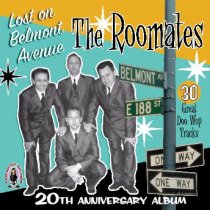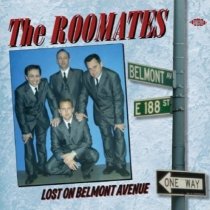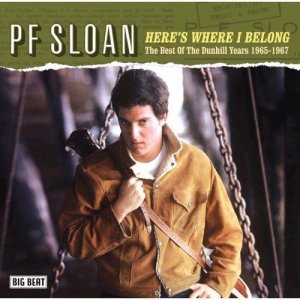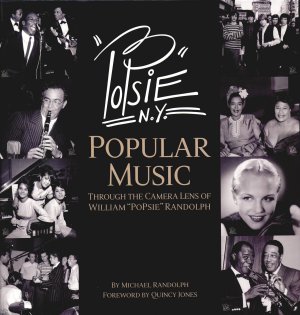
Reviews 2008 |
|---|
| ||||||
|
A NEW FIX FOR DOO-WOP ADDICTS THE ROOMATES (with one "m") 20 YEARS ON by Country Paul Payton Attention doo-wop addicts! If you can't get enough of Dion & the Belmonts, the Elegants and the Mystics; if Laurie is one of your favourite labels; if you are hip to the Roomates (spelled with one "m"), then there is a new fix for your addiction! The Roomates' 'Lost On Belmont Avenue' was released a few months ago on S'pop member Ash Wells' label, Rare Rockin' Records of Australia, and has just been reissued in the UK on Ace. It marks this durable and successful group's 20th anniversary, and once again, they have mixed in some unexpected covers with their own material. Consistency is a hallmark of the album. Throughout, the Roomates' harmonies are uniformly solid and tuneful, with lead vocals traded among Steve Webb (truly England's successor to Dion Di Mucci), Nick Kennedy, Glenn Brentnall and a couple of "guest" leads by bass player Gary Powell. Ears trained to the "white doo wop" sound will pick out the textural differences and hooks of the groups which influence the Roomates quoted in their original songs; less "educated" ears will just appreciate the overall quality of the work. There are many fine original tracks aboard: Steve Webb's 'Once In A While' benefits from guest bass singer Frankie B., who fills out their already rich harmonies. 'There's A Reason' features nice interplay with lead singer and composer Nick Kennedy and the group. The CD's second track, the fine uptempo 'Searchin' For That Girl', written by Steve, is led by Glenn Brentnall and again amplified by Frankie B. on bass. The Steve-and-Glenn pairing is in full force once more with 'The Girl That I Love', with a nice cha-cha beat. On some of the group's own songs, you'll hear musical quotes or allusions to some of their idols' more popular tracks, which they then use as a basis for new melodies and lyrics. But while knowing the "back story" of some of these selections adds to their enjoyment, you don't need it to appreciate the musicianship and quality of the Roomates' voices, both lead and background, as well as their obvious passion for the music. The cover songs reach farther afield than just the Bronx/Brooklyn/Staten Island axis. The Del Satins' 'Remember' is a logical choice, as is the obscure ballad 'Human Angel', discovered on an Elegants demo. Another pretty ballad, 'Two Shadows', comes from west coast group the Safaris ('Image Of A Girl'). The Choir's 'It's Cold Outside' is an unexpected choice that gets a credible doo-wop treatment. 'Come On', perhaps the most R&B-oriented track here, comes from Otis & the Distants, better known later as the Temptations; the guys do a great job on it featuring Glenn's soulful lead. Possibly the most inspired cover is 'Wonderin'', from Neil Young's 'Shocking Pinks' album, which the Roomates make their own with a refreshingly easy swing. It's a tribute to the group's talent that my favourite songs from
the album keep changing on each listening, but many of them are
cited above. You'll no doubt have several of your own when you get
your latest Roomates fix! THE ROOMATES 'LOST ON BELMONT AVENUE' (ACE CDCHD 1206) Available here: http://snipurl.com/3q0ha (Special thanks to Ed Engel, Crystal Ball Records, for help with research)
|
||||||
| |||
|
P.F. SLOAN A LOVINGLY EXECUTED TRAWL THROUGH HIS ARCHIVES by Harvey Williams Lou Adler (his boss at Dunhill Records) once described Phil Sloan as "a great mimic". And of course there are elements of homage on 'Here's Where I Belong', the new collection of Sloan's 1960s Dunhill recordings just out on Big Beat. Bear in mind, barely weeks before his Dunhill debut 'Sins Of A Family' was issued, Phil and his buddy Steve Barri were releasing side after side of brash surf-pop as the Fantastic Baggys. The way he moved so swiftly from this to the heartfelt protest of the early solo numbers included on this collection has to be admired for sheer audacity. But this does Phil a great disservice; there might be occasional nods of acknowledgement to his peers, but there's more to Sloan's protest-era work than mere pastiche. There's real craft here, and real passion. And in 1965, while the more - shall we say - "cerebral" end of the folk-rock axis was alienating half its fan base, Sloan was singing "You're old enough to kill, but not for votin'", a lyric that could be appreciated by even the most wigged-out teenybopper. Which was surely the point. Watching P F Sloan play a storming set to a bare few dozen dedicated folks at the Kilburn Luminaire last October was truly a joy, yet simultaneously baffling. His songbook is filled with universally loved and recognised classics; he should be selling out theatres and receiving endless plaudits from the monthlies. Yet somehow his standing in the pantheon of pop is not what it should be. Here he was in a small club venue, backed by a pick-up rhythm section, bashing out classic after classic to a select coterie of hardcore followers. Even more surprisingly, 'Here's Where I Belong' marks the debut appearance of much of this material on CD within the UK (and in some cases worldwide). An appreciation of his catalogue is clearly long overdue. Covers came thick and fast off the back of 'Eve Of Destruction'. Through 1965 and '66 the Searchers, Jan & Dean, the Turtles and many more hit big with compositions from the pen of Sloan (occasionally working again with Steve Barri). Phil's takes on these numbers ('Take Me For What I'm Worth', 'I Found A Girl' and 'Let Me Be', respectively) are included on the new Big Beat retrospective, but it's unclear if these are work demos or finished masters. Certainly, the recordings made for his debut LP 'Songs Of Our Times' - included here in its entirety - rarely extend beyond beat-combo arrangements, and are often pure folk, showcasing Phil's earnestly strummed acoustic and breathlessly blasting harmonica. But they are all the better for their simplicity, and the album as a whole works brilliantly as a document of a writer and his craft. Arrangements open out the further one delves into his career; much of Phil's second LP 'Twelve More Times' - also included here shy of just two tracks - shows a singer-songwriter at the peak of his powers, while the non-LP 45s released towards the end of Phil's tenure with Dunhill are truly a clutch of buried treasure. The heartbreaking baroque beauty of his final recording for the label, 'I Can't Help But Wonder, Elizabeth', particularly stands out as a great lost gem. By 1970 however, Sloan's star was on the wane; so much so in fact, that Jimmy Webb's eulogy for the death of the optimism and ambition of the sixties was entitled 'P F Sloan', drawing lyrical parallels between the dawning of Nixon-era politics and the sad but inevitable demise of songwriters such as Phil. Webb - another former Dunhill staff songwriter - once said Sloan was "one of the first songwriters to want to be a singer (too). There was definitely pressure for me to behave myself and just be a songwriter; he was one of the first guys to go up against that, and I look up to him". It seems that the era of the singer-songwriter that Sloan had effectively ushered in had all but killed his career. Thankfully the past few years have been kinder to Phil, with a
well-received solo set released in 2007 ('Sailover'), and an intermittent
but artistically successful return to the live circuit. More importantly,
he's viewing life with renewed energy and confidence. This lovingly-executed
trawl through his archives should redress the balance even further. P F SLOAN 'HERE'S WHERE I BELONG: More info: |
|||
| |||
|
WILLIAM "POPSIE" RANDOLPH PoPsie photographed everybody who was anybody on the music scene by David Bell An impressive photographic book seemed to leap off the shelves at Borders bookshop whilst Mick and I were picking up our tickets at the Lincoln Centre for Darlene Love's Christmas show. I've always been a lover and hopeful collector of classic 1960s black and white 8x10 photographs and this book has certainly indulged this passion of mine. Who can fail but be impressed at these works of art produced by the likes of James J. Kriegsmann and William "PoPsie" Randolph in New York and Bruno of Hollywood? PoPsie "scuffled for money" in a variety of jobs - towel boy in a midtown bordello, a shoeshine boy and then as a manager for bands, including Woody Herman and his idol, Benny Goodman, who gave him his first camera as a present. After marriage, he became a professional photographer in New York and was soon kept busy with publicity photo sessions, parties, concerts and club dates. The photographs selected for this book, chosen by his son Michael, certainly reflect the fast lane in which he lived his life, as they are filled with the vibrancy and pure joie de vivre of the big city music business. PoPsie shot everybody who was anybody on the music scene and also a lot of the minor celebrities and hopeful newcomers. He photographed the jazz scene of the 1940s and stunning pictures are included of Billie "Lady Day" Holliday, Glen Miller, Mary Lou Williams and Louis Prima. He continued snapping the stars of entertainment until his early retirement in the mid-1970s. His photographs for recording studios and music magazines are unique and detail an era of music that means so much to us all on Spectropop. I was astounded to find out that PoPsie left behind 100,000 negatives after his untimely death in 1978 and in this book we have a small representation of this astounding body of work. He photographed all the major music idols like Frank Sinatra, Elvis Presley when he came to New York to record his first records for RCA, Bobby Darin signing his contract for Atlantic Records and the king of the calypso craze, Harry Belafonte. Then there were the teen idols, Frankie Avalon, Fabian and Jimmy Clanton, and the British Invasion, led by the Beatles, the Rolling Stones, the Animals and the best female singing export from Britain, Dusty Springfield. There are also stunning images of the performers who played for Alan Freed at the Fox and Paramount theatres in the '60s - Bill Haley and his Comets, the Platters, the Cleftones and the Coasters. I was thrilled to see Motown stars in their youth and prime - the Supremes on the mean New York streets, the stunning Marvin Gaye in close up and also Smokey Robinson and the Miracles on the Ed Sullivan show in 1968. I could go on and on, naming all the big and lesser known artists that I love, but I will instead limit myself to just two more, who delighted crowds with their Christmas shows during that wonderful weekend in December of 2007 - La La Brooks with the very young looking Crystals and Ronnie Spector in the RCA Victor recording studios with her fellow Ronettes, Estelle and Nedra, at the "I'm On The Wagon" recording session. My two favourite New York girl groups are together in one book. You might have gathered by now that I'm a great admirer of this
very interesting photographic book and I would like to recommend
it wholeheartedly to fellow members of Spectropop. I'm already looking
forward to a second volume of PoPsie's wonderful work. My personal
choices for inclusion omitted in this volume are Connie Francis
and the first Queen of Motown, Mary Wells. POPSIE: POPULAR MUSIC THROUGH THE LENS OF WILLIAM "POPSIE" RANDOLPH Michael Randolph, with foreword by Quincy Jones (Hal Leonard Corporation)
More info:
|
|||
[ Reviews 2002 ] [ Reviews 2003 ] [ Reviews 2004 ]
[ Reviews 2005 ] [ Reviews 2006 ] [ Reviews 2007 ]
Spectropop text contents © copyright Spectropop unless stated otherwise. All rights in and to the contents of these documents, including each element embodied therein, is subject to copyright protection under international copyright law. Any use, reuse, reproduction and/or adaptation without written permission of the owners is a violation of copyright law and is strictly prohibited. All rights reserved.



